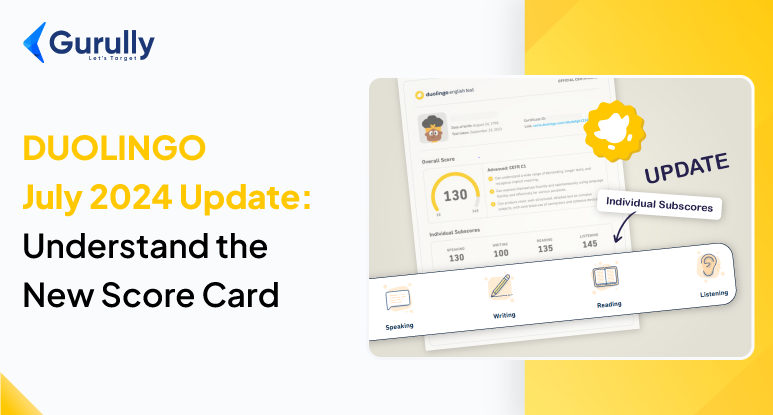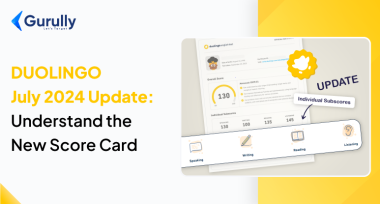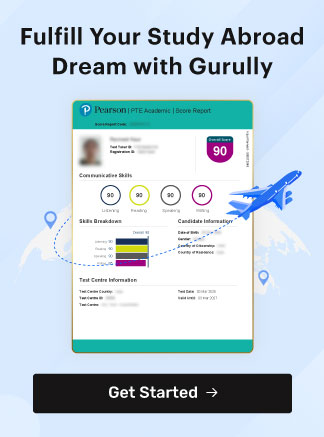For various reasons, the DUOLINGO Language Test is the first choice for most students regarding language proficiency tests. Besides knowing about the test format, you must know the latest exam updates. So here is the latest change in the scoring system that you must not miss.
The DET implemented a significant scoring update on July 1st, 2024, to provide a more nuanced picture of test-taker abilities. This update introduces individual skill subscores alongside the existing integrated subscores.
Introduction of New Subscores
The scoring scale spans 10 to 160. Certified tests offer individual subscores (reading, writing, listening, speaking) and integrated subscores (overall proficiency). Earlier, the DUOLINGO Language Test was in a single scoring system, which provided a limited view of a test-taker’s abilities. The July 2024 update introduces a two-tiered scoring system that provides a more detailed breakdown of skills.
Individual Subscore – The Addition to DUOLINGO English Test Score Card
These four subscores assess the fundamental building blocks of language proficiency: speaking, writing, reading, and listening. They measure a test-taker’s ability to understand and produce spoken and written language, providing a detailed picture of strengths and weaknesses in each area.
Integrated Subscore
These four subscores go beyond individual skills and reflect how these skills are used together in real-world communication. They combine the individual subscores in pairs to represent key aspects of language use.
- Literacy (reading & writing): This subscore reflects a test-taker’s ability to effectively understand and convey written information.
- Comprehension (reading & listening): This subscore assesses a test-taker’s ability to grasp verbal and text information.
- Conversation (speaking & listening): This integrated subscore evaluates a test-taker’s ability to participate in spoken interactions, combining their fluency and comprehension of spoken language.
- Production (speaking & writing): This subscore reflects a test-taker’s ability to express themselves clearly and effectively in writing and speaking.
Benefits For DUOLINGO Language Test Takers:
Introducing a new subscore gives several advantages to test-takers & empowers them to choose a more targeted & strategic approach for their preparation. By providing a detailed breakdown of your strengths and weaknesses across the four essential language skills, the subscores allow you to:
- Identify Areas for Improvement: Individual subscores pinpoint areas where you may need to dedicate more study time. This focuses on specific weaknesses which can significantly improve your overall score in a shorter period.
- Develop a Personalized Study Plan: Armed with insights from the subscores, you can tailor your study plan to address your specific needs. This may involve incorporating more speaking practice sessions if your speaking subscore is lower or finding resources to enhance your reading comprehension skills.
- Target Your Learning Efforts: By strategically focusing your efforts on areas with lower subscores, you can maximize your learning gains and improve your overall English proficiency.
- Showcase Strengths in Applications: Educational institutions may have varying requirements for different language skills. Subscores allow you to highlight your strengths in areas most relevant to your academic goals. For instance, if you are applying to a writing-intensive program, you can emphasize your high writing subscore.
Advantages For Institutions:
A Complete Picture: Institutions can better understand a candidate’s language proficiency beyond a single score. This allows them to make more informed decisions about candidates’ suitability for their programs. For instance,
- A program with a strong emphasis on written coursework may look for candidates with high scores in the literacy and reading subscores.
- Conversely, a program focusing on spoken communication may prioritize candidates with high conversation and listening subscores.
Data-Driven Decisions: The new DUOLINGO Language Test scoring system empowers universities to ditch the one-size-fits-all approach. By analyzing individual listening, speaking, reading, and writing subscores, institutions can make data-driven admissions decisions beyond just a single metric. This can lead to a more diverse student body with a wider range of language abilities.
Flexibility in Requirements: Institutions can set specific score expectations for different skills based on program needs. Tailoring requirements to each program’s specific demands allows for a more nuanced approach to admissions.
For example, a program requiring frequent presentations may set a higher threshold for the speaking subscore, while a research-oriented program may prioritize the reading and writing subscores.
How Scoring Is Done In DUOLINGO Language Test:
- The DET uses a computer program to assess your responses for tasks like “Read and Complete” or “Listen and Type.”
- Your answer gets compared to the correct one, and points are awarded based on how close it is.
- Don’t worry if you’re unsure! Skipping a question won’t hurt your score more than getting it wrong.
- In some cases, even an incorrect answer can earn you partial credit.
- It pays off to attempt every question, even if you’re not confident in your answer.
DUOLINGO Language Test Time Tips
- Since you control the test timing, pick a slot when you’re mentally and physically sharp.
- Ensure a comfortable and energized testing environment.
- Use the restroom before the test to avoid distractions.
- Give your brain a boost with a healthy snack before the test
- Put all electronic devices in another room and switch them off.
- Put away any pens and paper you might be tempted to use for notes (remember, that’s a no-no!).
- Inform those around you not to disturb you while you’re taking the test.
- Make sure your computer has enough battery life or is plugged in.
- Verify you have a strong and stable internet connection.
- Double-check that your identification isn’t expired.
- Remove your headphones and store them away.
After learning the exam time tips, you must focus on practicing. Gurully goes beyond basic drills with realistic simulations of the DUOLINGO exam. We provide you with an online practice platform. You will experience authentic mock test content that mirrors the exam, giving you a sneak peek at the questions you might encounter. Identify your strengths and weaknesses for targeted improvement.
Conclusion:
In a significant update implemented on July 1st, 2024, the DUOLINGO Language Test (DET) introduced a new two-tiered scoring system. This system provides a more detailed analysis of test-taker abilities alongside the existing single score.
The new system offers individual subscores for speaking, writing, reading, and listening, giving a clearer picture of strengths and weaknesses in each area. Additionally, integrated subscores combine these skills into real-world communication categories like Literacy, Comprehension, Conversation, and Production. This revamped scoring system benefits both test-takers and institutions.
Also Read:
- Duolingo Read Aloud Task – Tips To Score High With Practice Questions
- Duolingo Read And Select Made Easy: Tips to Score High With Sample Question & Answer
- Duolingo Read and Complete Question Tips and Tricks To Score High
- Your Guide to Duolingo English Test Fee – 2025
Useful Pages for DET Test Takers







